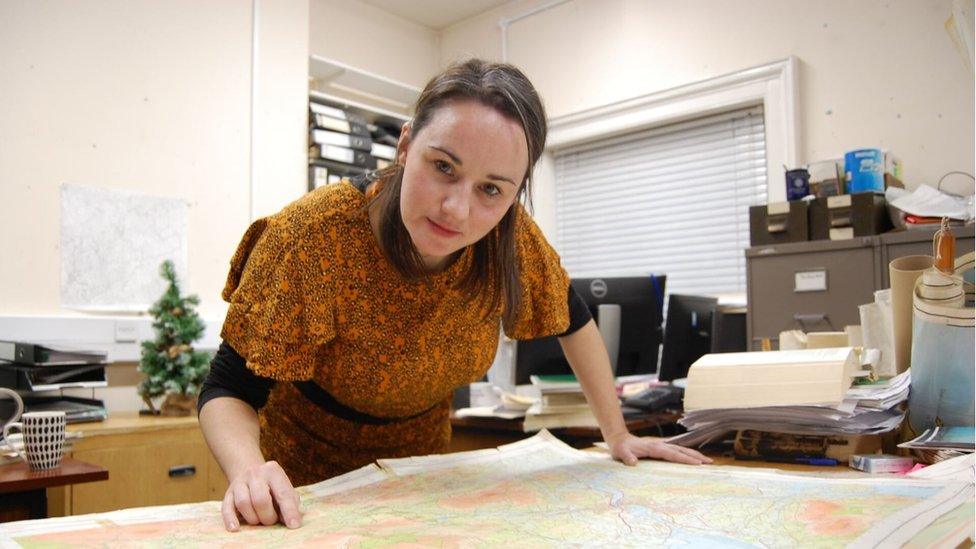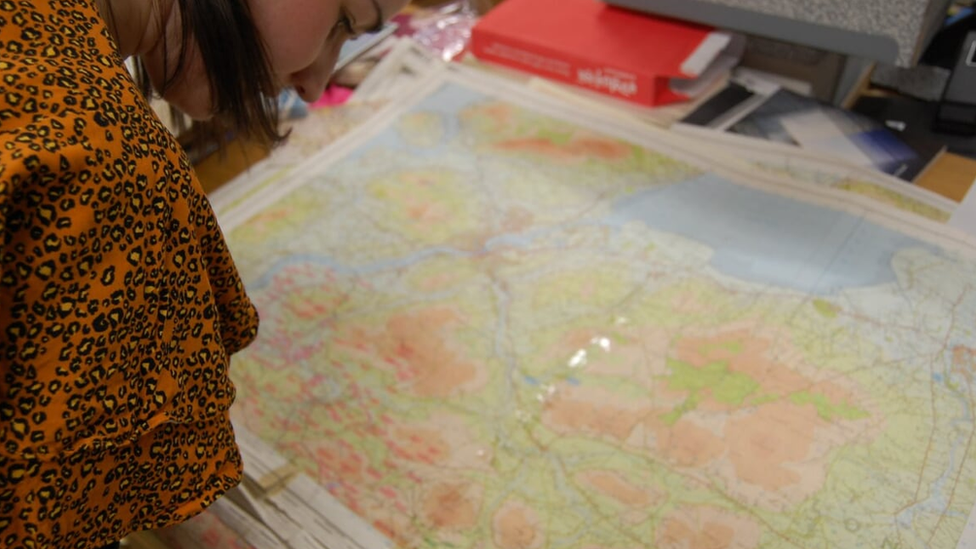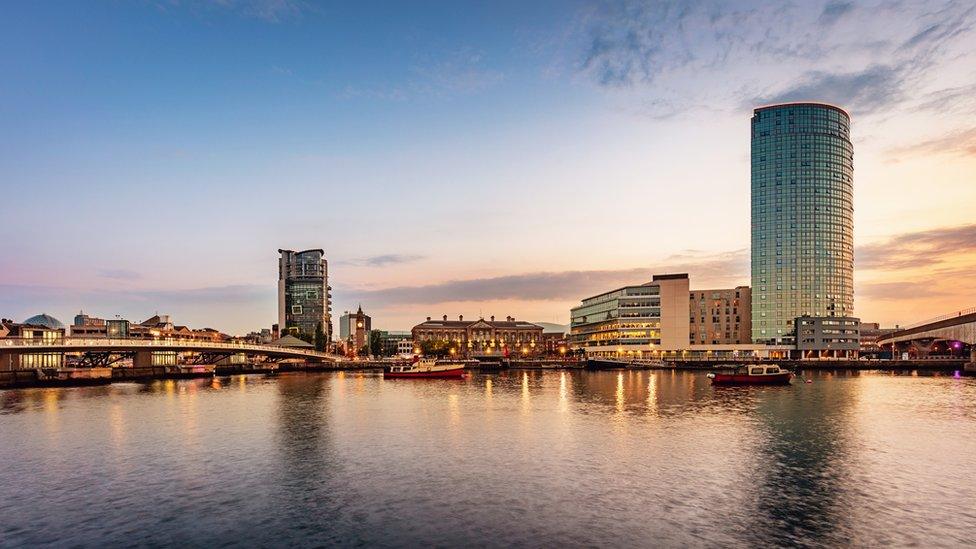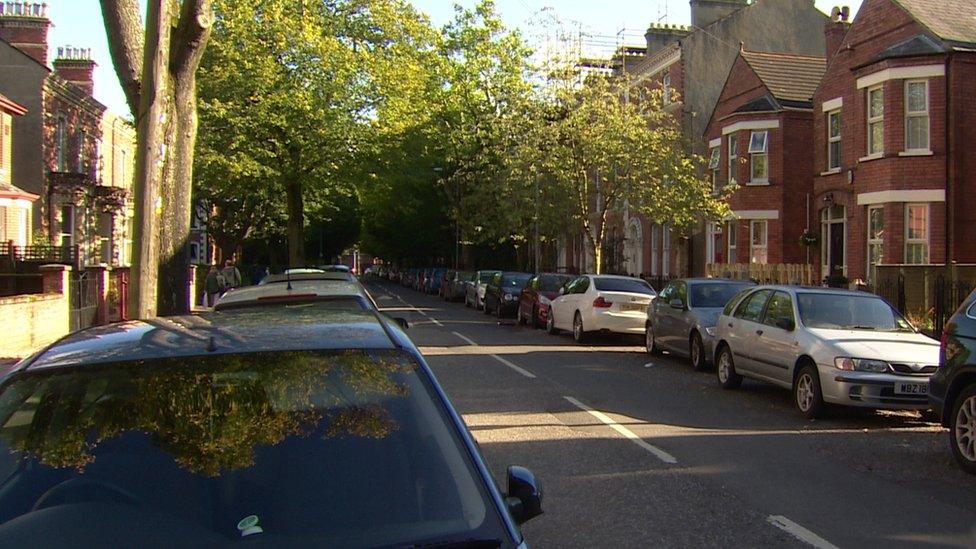Northern Ireland place names' mixed linguistic heritage
- Published

Dr Frances Kane studies the origins of Northern Ireland's place names
Belfast, Londonderry, Slemish, Anahorish - just some of the place names that reflect the mixed linguistic heritage of Northern Ireland.
Language can often be seen as a source of division, with nationalists and unionists, for example, mostly holding opposing views on whether the Irish language should have official status.
However, the same place names are shared by all.
Dr Frances Kane is a linguist with the Northern Ireland Place Name Project, external at Queen's University in Belfast.
Since 1987, it has been gathering and analysing historical forms of place names to try to establish what they originally meant.
The majority of its research involves trying to work out the meaning of townland names.
'Shared heritage'
Townlands are based on ancient Irish land divisions, not uniform in size but in terms of the quality of the land, preserved as small administrative units.
Most of them were coined before the arrival of the English language in Ireland, Dr Kane explained.
The fact that Irish names were not changed, but written down in English spelling "captured" the meaning of the names, she added.
"It's a bit ironic. There has to be a degree of knowledge of the Irish language to be able to identify the Irish in the now anglicised forms.
"The vast majority of the older names do come from Irish but, because of shifting populations and shifting language demographics, we see all of the languages.
"So if you look at north Down and the north Antrim coast you see a higher influence of Scots."

There are more than 64,000 townlands in Ireland
Dr Kane is keen to stress that place names represent a shared heritage.
"In a time when language is somewhat controversial, people get bent out of shape and annoyed about language, place names are actually a really nice resource because all the languages here appear in them, to varying degrees, but that is dictated by history, we can't change that," she said.
"It's not a case of 'our names' and 'your names', everybody has a place and all the places have a name."
A mixed history
An example of an Ulster-Scots townland name is the wonderful Hurtletoot in County Antrim, originally Hurkletoot - meaning a "hunched ridge".
Sometimes names are a mixture of languages, like Lisburn, also in County Antrim.
Experts feel that the local legend, in which it relates to the burning of the town in 1641, is not plausible and that it is more likely a combination of the Irish name Lisnagarvey - "the fort of the gamblers" - and the Scots burn, which means "stream".
And there are traces of other languages to be found in Ulster, such as Strangford which is of Norse origin, meaning "strong fjord".
There even seems to be a French place name, Pomeroy in County Tyrone.
Originally a name given to a house in the district, it is thought to be intended to represent the French pommeraie "apple orchard" or even Pomme de Roi - "apple of the king".
Belfast
A snapshot of some of the mixed heritage of Northern Ireland's place names can be found in Belfast, now a city of more than 4,000 named streets, avenues and roads.
Some of those have a profound historical meaning - some native to the place, others imported from far-flung corners of the British Empire.

Belfast is now a modern city but its name has been dated as far back as 665AD
They reflect the city's past, its politics and its people, albeit mostly the powerful ones.
The prime example is Great Victoria Street in the city centre, named for Queen Victoria in the mid-19th Century.
Chichester Street is another one of the main thoroughfares that runs through the city centre.
It was named after Arthur Chichester and his heir of the same name, who was the Earl of Donegall.
Arthur Chichester was an English administrator and soldier who was instrumental in the defeat of the Gaelic Irish clans of Ulster in the 17th Century.
Cooke Street, in the south of the city, is named after someone less powerful, but certainly influential - Rev Henry Cooke, a firebrand Presbyterian minister who opposed Catholic emancipation.
Big people need big houses and whilst many of Belfast's grander residences are now gone, many of their names are preserved in street names.
For example, Duncairn Avenue in the north of the city is ultimately named after the residence of Adam J Macrory, once a leading Belfast solicitor.
Before it existed, Duncairn Street was the old name for the lower part of Antrim Road.
The Ravenhill Road seems to have been named after a house built by the Marquess of Donegall for the trainer of his race horse.

The Holyland area is home to lots of students
Belfast's Holyland or Holylands area in the south of the city is mostly inhabited by students.
It is thought the name was coined after estate agent Sir Robert McConnell and builder James Rea took a trip to Egypt and Palestine in the 1890s.
Carmel Street is named after Mount Carmel, a mountain near Haifa in the north of modern-day Israel where the Bible says the prophet Elijah summoned the Israelites to choose between God and Baal.
On the other side of the River Lagan, in the upper Ormeau or Ballynafeigh district there is another cluster of themed streets, known to some as "The Punjab".
The streets in this area are all named after locations in India, Pakistan and Afghanistan in a throwback to the days of British rule or influence in those countries.
Baroda Street in named after a city in Gujarat, Agra Street after a city in Uttar Pradesh, famous for the Taj Mahal.
Horses for courses
No less than 12 streets in Belfast are named after horses - and, more particularly, winners of the the Derby.
Ladas, Pommern, Orby and Trigo are among the 12 winners from the late 19th and early 20th Centuries who feature in streets off the Castlereagh Road. but it is not clear why the equine-themed names were chosen.

Many of Belfast's place names predate the English language in the area; the modern cityscape originates in the Irish language and an older geography. Cromac Street is a great example of this.
It probably refers to the bend in the river where the Albert Bridge is now - Cromac or Cromóg is the Irish for little bend.
What about Amcomri Street in west Belfast? Is it Irish, or possibly Italian?
Nope! According to conversations with local informants, Amcomri is an anagram for "American Committee for Relief in Ireland".
- Published11 September 2019
